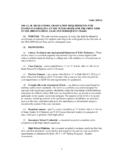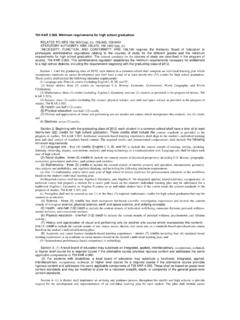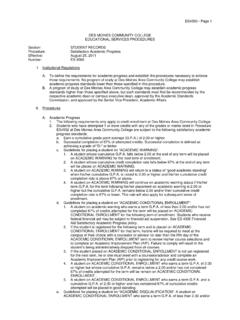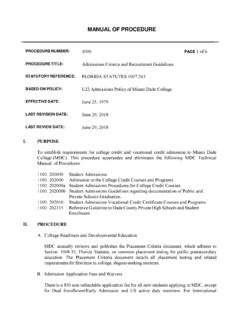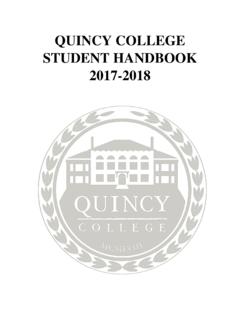Transcription of AB 167: FREQUENTLY ASKED Q - CFYETF
1 ab 167 : FREQUENTLY ASKED QUESTIONS I. Introduction Q1: What is ab 167 ? Assembly Bill 167 ( ab 167 ) refers to California legislation that amended section of the California Education Code ( ) to exempt pupils in foster care from school district graduation requirements that exceed state graduation requirements if the pupil transfers to the district, or transfers from one high school to another within a district in the 11th or 12th grade if the pupil would not be reasonably able to complete the additional district requirements. Approved by the Governor on October 11, 2009 and effective January 1, 2010, ab 167 requires school districts to provide notice to foster youth exempted from additional district requirements if failure to satisfy such local requirements will affect the pupil s ability to gain admission to a postsecondary educational institution.
2 Q2: What is the definition of a pupil in foster care ? ab 167 refers to a pupil in foster care but does not itself define this phrase. Legislative history suggests that ab 167 was meant to cover the same class of children as those covered by AB 490, which defines a foster child as one who has been removed from his or her home pursuant to Section 309 of the Welfare and Institutions Code, is the subject of a petition filed under Section 300 or 602 of the Welfare and Institutions Code, or has been removed from his or her home and is the subject of a petition filed under Section 300 or 602 of the Welfare and Institutions Code. ( (a)). Q3: What problem does ab 167 seek to address? California s foster children are often bounced from placement to placement and from school to school. These transitions often result in education related problems, including a loss of school credits, academic problems, and a delay in earning a high school diploma.
3 Studies show high school pupils who change schools even once are less than 50 percent as likely to graduate from high school as compared to high school pupils who do not change schools. California Foster Youth Education Task Force April 13, 2010 2 California sets minimum high school graduation standards for the state s school districts. However, school districts have flexibility with regard to additional coursework pupils are required to complete to graduate from high school. A foster child in high school forced to relocate to another school district in his or her junior or senior year may be faced with additional graduation requirements at his or her new school with little time to complete those courses in order to graduate with the rest of his or her class. Q4: What are the minimum high school graduation standards required by California? California requires pupils to complete all of the following one year courses, unless otherwise specified, while in grades 9 to 12, inclusive, in order to receive a diploma of graduation from high school ( (a)): A.
4 Three courses in English. B. Two courses in mathematics. (Including one year of Algebra I unless previously completed, ) C. Two courses in science, including biological and physical sciences. D. Three courses in social studies, including United States history and geography; world history, culture, and geography; a one semester course in American government and civics; and a one semester course in economics. E. One course in visual or performing arts or foreign language. For the purposes of satisfying the requirement specified in this subparagraph, a course in American Sign Language shall be deemed a course in foreign language. F. Two courses in physical education, unless the pupil has been exempted. Students may be exempted from physical education for a number of reasons. For example, if a student is ill or injured and a proper modified program cannot be provided for them or if a student is on a modified, half day schedule, they can apply for a temporary exemption.
5 Additionally, students may be exempted from physical education for two years if they have met five of the six standards of California s physical performance test given in ninth grade. ( 51241(b)(1).) Permanent exemptions are granted if the student is 16 or older and has been in the tenth grade for at least one academic year, is a postgraduate pupil, or is enrolled in a juvenile home, ranch, camp, or forestry camp school where physical recreation and exercise is provided pursuant to California requirements. ( 51241 (c)(1)(2)(3)). In addition to completing the coursework above, a pupil must receive passing scores on both California High School Exit Exams English and Math. ( 60851) Foster youth exempted from local graduation requirements by ab 167 must satisfy the above to receive a diploma of graduation . ( (c)). California Foster Youth Education Task Force April 13, 2010 3 Additional information regarding the state minimum graduation requirements can be found on the California Department of Education Website at II.
6 To Whom Does ab 167 Apply? Q5: Does ab 167 apply to all foster youth? No. ab 167 applies only to pupils in foster care who transfer into a district or between high schools within the district while they are in 11th or 12th grade, unless the school district makes a finding that the pupil is reasonably able to complete the additional requirements in time to graduate from high school while he or she remains eligible for foster care benefits. ( (c)). Q6: Does ab 167 apply if the school district to which the youth transferred has the same graduation requirements as the school district from where they came? Likewise, does ab 167 apply if the school to which the youth transferred has the same graduation requirements as his or her previous school? Education Code section makes no reference to the requirements of the school or school district from the school the foster youth came from.
7 The requirements of the prior school or school district do not affect whether ab 167 applies to a pupil in foster care. ab 167 applies to every pupil in foster care who transfers schools or school districts during his or her 11th or 12th grade year, unless the school district makes a finding that the pupil is reasonably able to complete the additional requirements in time to graduate from high school while he or she remains eligible for foster care benefits. Q7: Does ab 167 apply to foster youth who transferred prior to the passage of ab 167 ? Legislative language makes clear that ab 167 applies to all currently enrolled foster youth who transferred in the 11th or 12th grade, regardless of when the transfer occurred. Q8: Who determines whether a foster youth transferring into a new school or school district is in 11th or 12th grade? There is no state mandated method for determining a student s grade level.
8 This decision is left up to the school district and, in some cases, individual schools. Many school districts have established guidelines to determine a student s grade level. Oftentimes a student s grade level in high school is determined by the number of credits he or she has received. Other times, the student s age determines his or her grade level. Thus, the number of credits a student possesses might determine whether ab 167 applies to him or her in that it might determine whether he or she is in 11th or 12th grade. California Foster Youth Education Task Force April 13, 2010 4 Q9: Does ab 167 apply to a foster youth transferring to a new school district or school during his or her 10th grade summer? A student s grade level is determined by his or her school or school district. Many school districts base this determination upon the number of credits the student has received.
9 Thus, in most cases, a student is an 11th grader from the moment he/she has sufficient credits to qualify as such. This means that a typical student will be an 11th grader the summer after their 10th grade year, unless credit deficient. Q10: If a foster youth is an 11th grader and meets all of the minimum state requirements can the district award a high school diploma under the ab 167 exemption? Yes, as long as the minimum state requirements were met and the school district makes a finding that the pupil is not reasonably able to complete the additional requirements in time to graduate from high school while he or she remains eligible for foster care benefits. It is important, however, to consider whether graduating in the 11th grade is in the foster youth s best interest. Such a decision might negatively impact their ability to secure housing and other benefits.
10 In such a case best practice is to enroll the student in elective courses, ROP or vocational training. Q11: If a foster youth changes schools prior to the end of the semester and has met the minimum state requirements, do they need to complete the semester or is the district obligated to grant the diploma at that time under ab 167 ? ab 167 does not obligate school districts to grant diplomas mid semester or at any other time. Diplomas are awarded at times determined by school district policies and procedures. Thus, a district may grant a transferring foster youth a diploma prior to the end of the school year if the student has completed the minimum state requirements and the district makes a finding that the pupil is not reasonably able to complete the additional requirements in time to graduate from high school while he or she remains eligible for foster care benefits.

